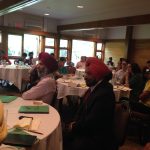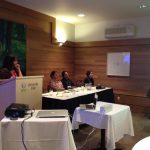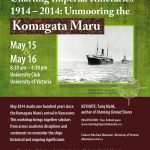The Centre for Indo Canadian Studies, UFV, in partnership with the University of Victoria, Trent University and the University of British Columbia presented a conference in commemoration of the centennial of the Komagata Maru tragedy. This conference, titled: “Charting Imperial Itineraries 1914-2014: Unmooring the Komagata Maru,” focused on three main themes:
The first area was the Global Imperial Histories, which encompasses a view that includes global racial histories, empire building and the politics of imperial in/exclusion. The significance of 1914 in the moment of “empire’s end”, the outbreak of World War 1, the ‘Red Scare’ among other key events shapes the breadth and texture of the imperial itineraries that informed and were produced by the Komagata Maru and its commemorative stories. The histories of this moment are necessarily revisited through critiques of patriarchical power, homonationalism, and the increasing mobility/ restrictions of people of colour.
The second theme centered on Local and Global Encounters of Imperialism. Scholars writing of the Komagata Maru, while focused on the local and national contexts of Vancouver and Canada respectively, have said nothing of how this event was related to other ongoing colonial processes including the displacement and dispossession of Indigenous lands and peoples through British and French resettlement. This second area of inquiry thus seeks to expand theoretical understandings of nationalism and nation-building, and situates these within imperial studies. It moves theories of race beyond the conventional focus on majority-minority relations (South Asians migrants – British rulers) to include the relational dynamics between marginalized groups (e.g. South Asians – Indigenous) within the context of empire.
The third theme was on Transnational Legacies of the Komagata Maru across Time. This theme centres the temporal scale of the Komagata Maru that shapes historical and contemporary acts of memory, memorialisation and the history of the present, specifically in terms of viewing this story not simply as a memorial relegated to the past, but in terms of the various temporal plains in which the Komagata Maru has become present. Challenging the historical periodization of the “event” as being located in 1914, instead we explore the events of the Komagata Maru as a history of the present so as to examine the various ruptures, discontinuities, breakages with imperial social, political, and cultural productions and resistances over the past century. This third area of inquiry will enrich contemporary understandings of security and anti-terrorism, migration and diaspora, and resistance and radicalism by placing these within a longer historical context.
The conference was very well attended and included top academic scholars and emerging young scholars from across North America and the world. In addition, the conference included a community event at the Royal BC Museum featuring a keynote address from author Tariq Malik, author of Chanting Denied Shores.






